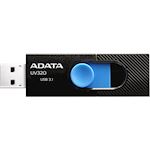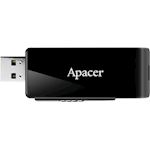USB Flash Drives
Frequently asked questions
-
How to format the USB to NTFS in Windows XP?
These procedures will guide you to format your USB flash drive to NTFS in Windows XP:
- Right-click on my computer and then select manage to open device manager
- Open disk drive, right-click on the USB Flash Drive and then select properties
- Select policies tab, and then select optimized for performance
- Press OK
- The NTFS option shall be enabled in the Windows format.
Note 1: About Windows default format tool, please refer to question 6
-
Why is the USB Flash Drive actual storage capacity slightly less that the product specification?
All storage products will display a lower than stated memory capacity. The reason is the general used method for calculation of megabyte used by manufacturers:
The calculation for a 32GB is done like this:
32GB=32.000.000.000 Bytes, 1024Byte = 1KB
32.000.000.000/1024= 30.250.000KB, 1024KB=1MB
31.250.000.000/1024= 30.517,58MB, 1024MB=1GB
30.517,58/1024= 29,8GB
Therefore a 32GB USB Flash Disk will show 29,8GB under Windows.
-
How to use device manager to format my USB Flash Drive?
Before format, please backup all your data and make sure you select the correct drive. The following steps will show you how to use device manager to format.
- Right-click on my computer and select manage.
- Click on disk management.
- Right-click on your correct device, and select format. If you need to format NTFS or exFAT file format, please refer to question 6.
- Confirmation dialog will be showed on screen, click yes to continue.
- Choose your file format and click ok to continue.
- Confirmation dialog will be showed on screen again, click cancel to give up format process, click ok to continue your format process.
-
How do I know that my USB Flash Drive is correctly inserted into the USB port?
Please make sure your device is correctly inserted into the connector. If your computer still can't detect your device, please reverse the connector and insert it again.
If your computer detects your device, the first time driver installation process will be shown in the right corner of screen. If your computer device autorun function is enabled, the dialog window will show on the screen. Then you can choose which method you want to open your device. You also can use device manager to check your device status.
-
My USB Flash Drive was recognized by my computer, but it does not appear in My Computer, how do I access my USB?
Another device may have been assigned with the same drive letter, therefore you have a drive conflict. If you want to solve this problem, please follow the instructions below to reassign USB Flash drive initial.
- Click Windows start icon.
- Select run.
- Enter diskmgmt.msc and click on the ok to open disk manager.
- Right-click on USB flash drive, then select change drive letter and paths.
- Click on the edit.
- Reassign the drive letter to another one that is not used by another device.
- Click on the ok to save your settings.
-
How do I prevent files from being damaged or lost from the USB Flash Drive?
We strongly recommend you to connect your USB flash drive to the rear side USB ports on your computer, and please avoid using an USB hub or extension cable. Please do not use several USB devices at the same time to avoid the possibility of insufficient power supply. Please make sure you use the safety remove option whenever you would like to disconnect USB Flash drive from your computer. You can refer to question 12 perform safety remove procedure.
-
How do I know if my computer supports USB 2.0, what can I do if not?
You can verify if your computer is supporting USB 2.0 or not by following instructions:
- Right-click on my computer.
- Select device manager
- Expand universal serial bus controllers node, and verify if you can find USB 2.0 or enhanced host controller interface in it.
If your computer is not USB 2.0 ready, please refer to the motherboard user guide to verify if your motherboard support USB 2.0 standard or not. In some cases, you will need to install the driver that is packaged with your motherboard driver CD. If you are using Windows operation system, please make sure that you have updated your system with the latest service pack version.
-
What is the difference between USB 2.0 & USB 1.1?
A low-speed rate of 1.5 Mbit/s (~183 KB/s) is defined by USB 1.0. It is very similar to "full-bandwidth" operation except each bit takes 8 times as long to transmit. It is intended primarily to save cost in low-bandwidth human interface devices (HID) such as keyboards, mice, and joysticks.
The full-speed rate of 12 Mbit/s (~1.43 MB/s) is the basic USB data rate defined by USB 1.1. All USB hubs supports full-bandwidth.
A high-speed (USB 2.0) rate of 480 Mbit/s (~57 MB/s) was introduced in 2001. All hi-speed devices are capable of falling back to full-bandwidth operation if necessary; they are backward compatible. Connectors are identical.
TeqFind's Choice:
-
 128GB USB 3.2 Flash Disk Drive, ADATA UV320, Black/Blue€ 19.44 excl. VAT
128GB USB 3.2 Flash Disk Drive, ADATA UV320, Black/Blue€ 19.44 excl. VAT
€ 23.52 incl. VAT -
 Apacer USB3.0 Flash Drive AH350 128GB Black RP€ 11.72 excl. VAT
Apacer USB3.0 Flash Drive AH350 128GB Black RP€ 11.72 excl. VAT
€ 14.18 incl. VAT
